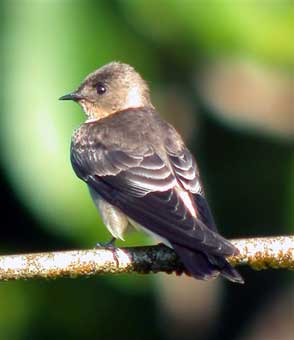Rough-winged Swallows
 Every day on my way to and from work (my whopping 6 minute commute), I pass a grassy field that always has several Northern Rough-winged Swallows (Stelgidopteryx serripennis) zooming high and low catching insects in their acrobatic way. From my perspective of birding, this swallow is a rather under appreciated member of its family. It's easily overshadowed by the shiny Tree and Violet-green Swallows and the colorful Barn, Cave, and Cliff Swallows. It's even slightly overshadowed by the it's slightly more well-marked cousin, the Bank Swallow.
Every day on my way to and from work (my whopping 6 minute commute), I pass a grassy field that always has several Northern Rough-winged Swallows (Stelgidopteryx serripennis) zooming high and low catching insects in their acrobatic way. From my perspective of birding, this swallow is a rather under appreciated member of its family. It's easily overshadowed by the shiny Tree and Violet-green Swallows and the colorful Barn, Cave, and Cliff Swallows. It's even slightly overshadowed by the it's slightly more well-marked cousin, the Bank Swallow.
The Northern Rough-winged Swallow is a small, brown swallow with dull to creamy white plumage below. It's head, chest, sides, and flanks are grayish-brown. The throat is usually paler and the tail is square. Its name comes from the rough edge to the outer wing feathers. When Audubon first found this bird, he thought he had found a Bank Swallow. He noticed the rough wing feathers and gave it the common name it now has.
It can be difficult to separate Rough-wingeds from the other brown-backed swallows. It's similar in flight to the Bank Swallow, but can be easily separated when perched. The Bank Swallow has a distinct brown breast band. Young Tree Swallows also look similar, but are dull white below with a smudgy brown breast band. "The tone of the upperparts is helpful on flying birds. Young Tree Swallows are usually a grayer shade of brown than Bank or Northern Rough-winged Swallows. Bank Swallows often look paler on the lower back and rump, which contrasts with dark wings. Northern Rough-wings tend to look uniformly brown above." (Thanks to Mark Johns)
Northern Rough-winged Swallows are found across the US and into southern Canada in summer, but winter along the Gulf Coast and in Central America. During the breeding season, they usually nest in river banks, railroad embankments, gravel pits, and sometimes even in drainpipes and old Kingfisher nests. They feed while on the wing, dining on a variety of insects including wasps, beetles, and mosquitos. Lucky for us, these swallows are doing well in the US. So, next time you see one of these guys zoom by you, give it a second glance and appreciate its subtle beauty.
On another note, the Northern Rough-winged Swallow has a southern relative named... wait for it... the Southern Rough-winged Swallow (Stelgidopteryx ruficollis). This was actually the first life bird I got in Costa Rica as one zipped by our bus as we pulled out of the airport. Its slightly more colorful than its northern cousin, but similarly rough-winged. 
Southern Rough-winged Swallow


4 comments:
Intersting stuff. How common is this swallow? I'm not sure I've ever seen one. I'll have to pay more attention.
Cornell says that it's "fairly common" across the US. It seems to adapt to a variety of habitats as long as there is a crevice, bank, or pile of dirt for it to nest in.
I checked my old Petersen guide, and I have the rough-winged swallow checked off, so I have seen one, but that was probably nearly 30 years(yikes!)ago. Thanks for the reminder. It's time to renew my acquaintance with this interesting bird.
My daughter spotted what I believe was an injured rough winged swallow this weekend in NC. We coralled it and took it home ane the next day took it to a wildlife rehab center. It had a gash on its wing and they are giving him antibiotics. I became rather attached to the cute little fellow and I hope he recovers.
Post a Comment